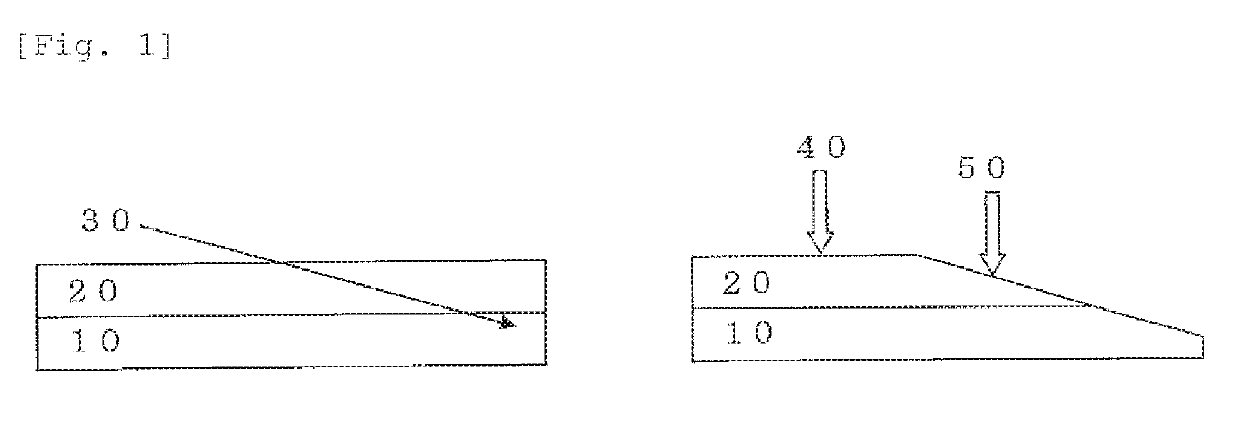Antifogging laminate
a laminate and anti-fogging technology, applied in the field of laminates, can solve the problems of being easily decreased in transparency, low durability, and inability to stand prolonged use, and achieve the effect of excellent hydrophilicity and anti-fogging properties
- Summary
- Abstract
- Description
- Claims
- Application Information
AI Technical Summary
Benefits of technology
Problems solved by technology
Method used
Image
Examples
synthesis example 1
[0368]
[0369]A reaction flask was charged with 936.9 g of methanol subjected to degassing under reduced pressure, and 38.3 g (0.580 mol) of a KOH flake having a purity of 85 wt % was gradually added thereto with stirring, so that the KOH flake was allowed to be completely dissolved. Then, 124.0 g (0.585 mol) of acrylamide-t-butylsulfonic acid (hereinafter referred to as “ATBS”.) was loaded in portions for neutralization (pH=7.6), to give a neutralized mixture including potassium acrylamide-t-butylsulfonate (hereinafter referred to as “ATBS-K”.)
[0370]Then, a liquid mixture of 10.3 g (0.0725 mol) of glycidyl methacrylate (hereinafter referred to as “GMA”.), 21.1 g (0.0725 mol) of methacryloyloxypropyltriethoxysilane (hereinafter referred to as “KBE-503”.) and 2.0 g of methanol, and a liquid mixture of 0.63 g of t-butylperoxy-2-ethylhexanoate (hereinafter referred to as “perbutyl-O”.) as a polymerization initiator and 6.3 g of methanol were each prepared. Each of the liquid mixtures was...
example 1
[0374]
[0375]After 0.75 g of the copolymer (i) produced in Synthesis Example 1 was mixed with 3.75 g of water, to give a solution, and then the solution was mixed under stirring with 16.65 g of 2-methoxyethanol (hereinafter referred to as “EGM”.), 2.56 g of tetraethoxysilane (hereinafter referred to as “TEOS”.) and 0.5 g of 5 wt % sulfuric acid, and 0.75 g of 1 wt % Tris(2,4-pentanedionato)-aluminum(III) diluted with EGM. The obtained liquid mixture was stirred for 30 minutes, to thereby give a colorless and transparent coating composition A1 having a solid content of 6 wt % (NV). The weight ratio of copolymer (i) / TEOS (in terms of SiO2) in the composition was 50 / 50.
[0376]
[0377]To 100 g of tetradecaethylene glycol diacrylate (trade name: A-600 manufactured by Shin Nakamura Chemical Co., Ltd.), 3.0 g of 2-hydroxy-2-methyl propiophenone (trade name: DAROCURE 1173 manufactured by Ciba Japan K.K.) and 0.25 g of a silicone surfactant (KL-100 manufactured by Kyoeisha Chemical Co., Ltd.) we...
example 2
[0389]
[0390]To 70 g of tricosaethylene glycol diacrylate (trade name: A-1000 manufactured by Shin Nakamura Chemical Co., Ltd.), 30 g of 1-methoxy-2-propanol and 2.1 g of 2-hydroxy-2-methyl propiophenone (trade name: DAROCURE 1173 manufactured by Ciba Japan K.K.) were added, and then the resultant mixture was stirred and blended, to give a coating composition B2.
[0391]
[0392]Except that a sample was produced by applying the urethane primer onto the blue plate glass and curing it as in Example 1 and the coating composition B2 was applied to the surface of the primer layer by a spin coater at 500 rpm for 60 seconds to form a water absorbing layer having a thickness of 12 μm, the same method as in Example 1 was performed to form a laminate.
[0393]Table 2 shows results of the evaluations.
PUM
| Property | Measurement | Unit |
|---|---|---|
| Diameter | aaaaa | aaaaa |
| Water absorption | aaaaa | aaaaa |
| Hydrophilicity | aaaaa | aaaaa |
Abstract
Description
Claims
Application Information
 Login to View More
Login to View More - R&D
- Intellectual Property
- Life Sciences
- Materials
- Tech Scout
- Unparalleled Data Quality
- Higher Quality Content
- 60% Fewer Hallucinations
Browse by: Latest US Patents, China's latest patents, Technical Efficacy Thesaurus, Application Domain, Technology Topic, Popular Technical Reports.
© 2025 PatSnap. All rights reserved.Legal|Privacy policy|Modern Slavery Act Transparency Statement|Sitemap|About US| Contact US: help@patsnap.com



